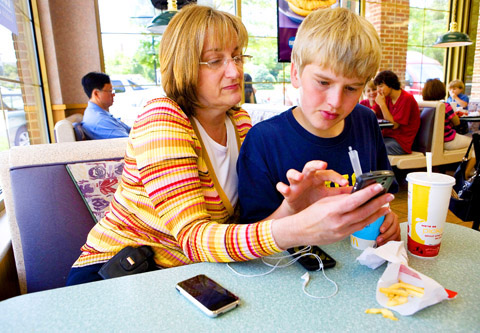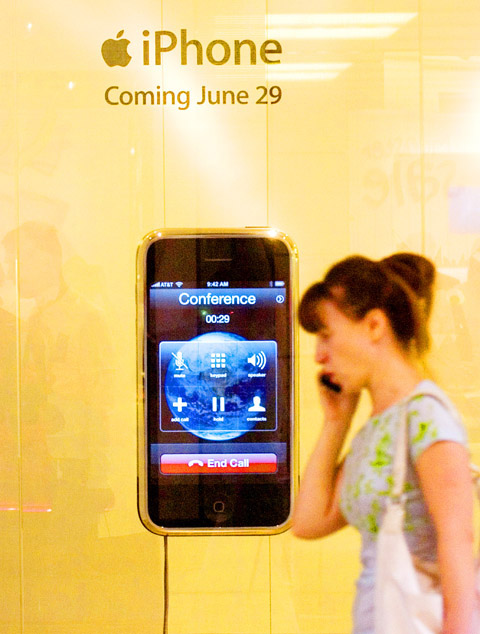If recent history is any guide, roughly a third of the people snapping up Apple’s new iPhone are likely to carry it in a purse.
In a big shift for the phone industry, American women have emerged as eager buyers of not just iPhones but of all so-called smartphones — BlackBerrys, Treos and other models.
In the last year the number of women in the US using smartphones more than doubled to 10.4 million, growing at a faster pace than among men, according to Nielsen Mobile, which tracks wireless trends.

PHOTO: NY TIMES NEWS SERVICE
The trend is mirrored in sales of the iPhone. In October, nearly one out of four owners of the iPhone was a woman, according to Nielsen. By March that number rose to one in three. The iPhone model announced on Monday, with faster Internet access and mapping features, may accelerate the shift.
Smartphones are cheaper now — as little as US$99 for the petite BlackBerry Pearl — and are better designed. Women have been using them for years in business, of course, but many are finding that the phones can also help manage their families’ time-pressured schedules and keep them in touch with friends.
“You are not seen as a geek anymore if you have a smartphone,” said Carolina Milanesi, research director at Gartner Group, a research firm. “Women, including wives and mothers, need to keep track of their busy lives, too.”

PHOTO: NY TIMES NEWS SERVICE
The phone makers and service providers increasingly see women as the path to the entire household. According to Verizon Wireless, 71 percent of American women make the decision about their family’s wireless choices, including phones and service plans. (Smartphones require data plans that can cost US$30 or more a month.)
As a result, smartphone makers are beginning to market specifically to women. Research In Motion, based in Waterloo, Ontario, has taken out ads for its BlackBerry phones in Elle, Martha Stewart Living and Oprah Winfrey’s magazine O.
Lina Caputo, a part-time teacher from Waterloo, said her husband, who runs a networking company that is not connected to RIM, gave her a second-hand BlackBerry a year ago so they could better manage their two sons’ schedules.
Getting In Sync
“It was a nightmare with the four of us,” Caputo said, ticking off a list of her sons’ after-school activities, including soccer, hockey and swim practices. “My sons have about 10 hours of sports. It got to be too much. It was confusing.”
Caputo said she and her husband regularly sync their calendars. She uses the phone to send e-mail to her husband when she gets home safely from a snowy trip, and to keep in touch with close friends who regularly gather at a local coffee shop. When six of them went to Las Vegas for a “girls’ weekend” in February, five of them brought their BlackBerrys so they could keep track of each other and their kids back home.
Caputo is no longer using her husband’s hand-me-downs. On Mother’s Day he bought her a BlackBerry Pearl, one of the company’s best-selling phones. “I don’t equate it to getting a vacuum or a blender,” she said, when asked if she would have rather received flowers or chocolate. “Besides, my girlfriend got a red one for Valentine’s Day.”
David Christopher, the marketing chief of AT&T’s wireless division, said women were less likely to be wowed by fancy gadgets. Instead, as smartphones have become sleeker, smaller and cheaper, they have become more appealing to them.
“Now they are small enough to be in your purse or pocket,” Christopher said. “Design does matter.”
Competitors have been working hard to catch up to Apple in the design department. This month Sprint, will begin selling the Instinct, a touch-screen device created by Samsung that shares many features with the iPhone. And this summer RIM is adding the BlackBerry Bold, which, like the iPhone, runs on a faster mobile network.
Nielsen’s research shows that women are more price-sensitive than men and half as likely to care about whether they have used a specific brand before. Still, more traditional pitches do have their own appeal. RIM and Verizon Wireless were successful last Valentine’s Day with promotional events for a pink BlackBerry Pearl. Even then, picking the right hue was tricky.
“We picked a shade of pink that fit in all kinds of settings — not too flashy,” said Mark Guibert, vice president of corporate marketing at RIM. “It was the only color that was purely driven by the female audience. Years ago the market was much more focused solely on function. Now there is more focus on lifestyle.”
It’s about time, said Milanesi, the research director. When she used to attend mobile trade shows with a male colleague, she said, “they showed him the cool phone and showed me the phone with a mirror.”
“Companies need to be careful to not think that to sell smartphones they just need to be pink,” she said. “There are other things women want.”
Steve Jobs, Apple’s chief executive, understood this when his engineers created the iPhone. Although it is not marketed specifically to women, it has a clean design and multimedia features that many women say they like, but that the BlackBerry lacks.
Kayne Lanahan, who lives in New York and is the owner of an online music site, bought an iPhone last October after her dog wagged its tail and tipped her Nokia cell phone into a cup of coffee. She didn’t even contemplate a BlackBerry, stung by the image of the work-obsessed executives she knew when she worked at the News Corp who furiously e-mailed their bosses during meetings and at the table during late dinners.
“I didn’t want to be that person,” Lanahan said. “This is such a girly thing to say, but I love the iPhone’s design.”
A BLACKBERRY FOR WORK,
AN IPHONE FOR PLEASURE
That, and the fact that the US$399 device suited her technological lifestyle. Lanahan owns an Apple MacBook Pro laptop and five iPods. She uses the iPhone’s notepad function to track restaurant recommendations from friends. She takes pictures at concerts, some of which show up on her Web site. And once, when her name didn’t appear on the guest list at a club she was invited to, she used her iPhone to show the bouncer an e-mail that proved she was invited.
Plenty of other women are finding that smartphones are much more than a tether to the office. According to Nielsen, two-thirds of women with smartphones say they use them primarily for pleasure rather than business. The contrast with men is stark: Just 42 percent of male smartphone owners say the same.
But what is a woman to do if she wants all the features of an iPhone but her corporate e-mail works only with the BlackBerry? In the case of Andrea Newman, a senior vice president of government affairs for Northwest Airlines, she decided to get both.
“I have the BlackBerry for work and I bought the iPhone for fun,” she said. “Using e-mail on the iPhone is more difficult, which is why I use the BlackBerry.”
Still, she liked her BlackBerry so much that she bought one for her 21-year-old daughter so they could communicate when she went to Europe. And for her 12-year-old son she bought an iPod Touch (which can access the Internet over Wi-Fi) so they could e-mail too.
Newman was asked which phone she would keep if she was stuck on a desert island.
“Ewww,” she said. “I never thought about it. Really? If I could only have one?” Minutes passed as Newman weighed the pros and cons of each. Finally, she said, “I guess if I wasn’t using the BlackBerry for work, I’d have an iPhone.”

The unexpected collapse of the recall campaigns is being viewed through many lenses, most of them skewed and self-absorbed. The international media unsurprisingly focuses on what they perceive as the message that Taiwanese voters were sending in the failure of the mass recall, especially to China, the US and to friendly Western nations. This made some sense prior to early last month. One of the main arguments used by recall campaigners for recalling Chinese Nationalist Party (KMT) lawmakers was that they were too pro-China, and by extension not to be trusted with defending the nation. Also by extension, that argument could be

Aug. 4 to Aug. 10 When Coca-Cola finally pushed its way into Taiwan’s market in 1968, it allegedly vowed to wipe out its major domestic rival Hey Song within five years. But Hey Song, which began as a manual operation in a family cow shed in 1925, had proven its resilience, surviving numerous setbacks — including the loss of autonomy and nearly all its assets due to the Japanese colonial government’s wartime economic policy. By the 1960s, Hey Song had risen to the top of Taiwan’s beverage industry. This success was driven not only by president Chang Wen-chi’s

Last week, on the heels of the recall election that turned out so badly for Taiwan, came the news that US President Donald Trump had blocked the transit of President William Lai (賴清德) through the US on his way to Latin America. A few days later the international media reported that in June a scheduled visit by Minister of National Defense Wellington Koo (顧立雄) for high level meetings was canceled by the US after China’s President Xi Jinping (習近平) asked Trump to curb US engagement with Taiwan during a June phone call. The cancellation of Lai’s transit was a gaudy

The centuries-old fiery Chinese spirit baijiu (白酒), long associated with business dinners, is being reshaped to appeal to younger generations as its makers adapt to changing times. Mostly distilled from sorghum, the clear but pungent liquor contains as much as 60 percent alcohol. It’s the usual choice for toasts of gan bei (乾杯), the Chinese expression for bottoms up, and raucous drinking games. “If you like to drink spirits and you’ve never had baijiu, it’s kind of like eating noodles but you’ve never had spaghetti,” said Jim Boyce, a Canadian writer and wine expert who founded World Baijiu Day a decade